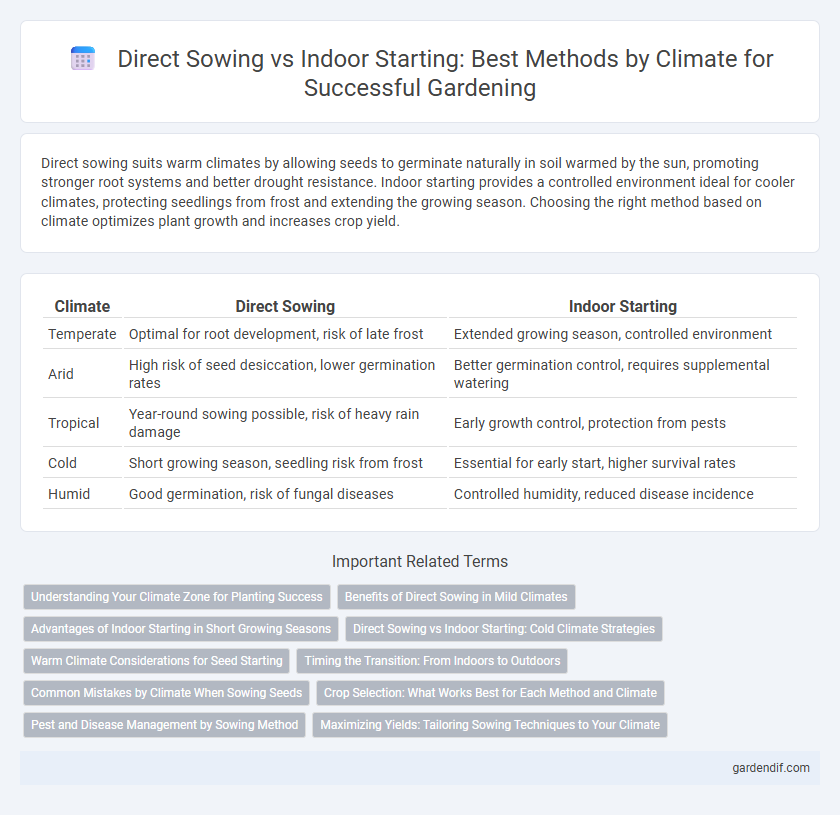
Direct Sowing vs Indoor Starting (by climate) Illustration
Direct sowing suits warm climates by allowing seeds to germinate naturally in soil warmed by the sun, promoting stronger root systems and better drought resistance. Indoor starting provides a controlled environment ideal for cooler climates, protecting seedlings from frost and extending the growing season. Choosing the right method based on climate optimizes plant growth and increases crop yield.
Table of Comparison
| Climate | Direct Sowing | Indoor Starting |
|---|---|---|
| Temperate | Optimal for root development, risk of late frost | Extended growing season, controlled environment |
| Arid | High risk of seed desiccation, lower germination rates | Better germination control, requires supplemental watering |
| Tropical | Year-round sowing possible, risk of heavy rain damage | Early growth control, protection from pests |
| Cold | Short growing season, seedling risk from frost | Essential for early start, higher survival rates |
| Humid | Good germination, risk of fungal diseases | Controlled humidity, reduced disease incidence |
Understanding Your Climate Zone for Planting Success
Understanding your climate zone is crucial for determining whether direct sowing or indoor starting is more effective for your garden. Warmer zones with longer growing seasons benefit from direct sowing, allowing seeds to germinate naturally in soil with optimal temperature and moisture. Cooler or variable climates often require indoor starting to protect seedlings from frost and extend the growing period before transplanting outdoors.
Benefits of Direct Sowing in Mild Climates
Direct sowing in mild climates offers significant benefits such as reduced transplant shock, leading to stronger root development and healthier plant growth. It optimizes natural soil conditions and moisture availability, enhancing seed germination rates and minimizing water usage. This method also lowers labor and resource costs by eliminating the need for indoor seedling trays, artificial lighting, and temperature control, making it an efficient choice for sustainable agriculture.
Advantages of Indoor Starting in Short Growing Seasons
Indoor starting offers significant advantages in short growing seasons by providing controlled temperature and light conditions that promote faster seed germination and seedling growth. This method reduces the risk of frost damage and extends the effective growing period, enabling earlier transplanting and improved crop yields. By optimizing environmental factors indoors, gardeners and farmers can ensure stronger, healthier plants better suited for climate constraints.
Direct Sowing vs Indoor Starting: Cold Climate Strategies
Direct sowing in cold climates involves planting seeds directly into the soil once temperatures stabilize above freezing, which benefits crops adapted to cooler conditions and reduces transplant shock. Indoor starting allows for early germination in controlled environments, protecting seedlings from frost and extending the growing season in regions with short summers. Choosing between these methods depends on the specific crop's cold tolerance, regional frost dates, and the grower's ability to provide adequate indoor lighting and temperature control.
Warm Climate Considerations for Seed Starting
Direct sowing in warm climates benefits from consistent soil temperatures that promote rapid germination and strong seedling growth, reducing the risk of transplant shock. Indoor starting may be less necessary but can still protect seeds from pests and erratic weather during early stages. Warm climate seed starting prioritizes soil warmth and moisture control to ensure optimal seedling development and successful crop establishment.
Timing the Transition: From Indoors to Outdoors
Timing the transition from indoor seed starting to direct sowing outdoors depends heavily on local climate conditions, with frost dates playing a crucial role in scheduling. Seedlings started indoors require gradual acclimatization through hardening off to minimize transplant shock before exposure to outdoor temperatures and variable weather. In temperate climates, moving plants outdoors a few weeks after the last frost ensures optimal growth, while in warmer regions, direct sowing can often be initiated earlier, reducing the need for indoor starts.
Common Mistakes by Climate When Sowing Seeds
Direct sowing in cold climates often leads to seed rot and poor germination due to overly wet soil conditions, while indoor starting avoids these risks by providing controlled warmth and moisture. Common mistakes include sowing cold-sensitive seeds too early in direct soil, resulting in stunted growth, and failing to harden off indoor seedlings before transplanting, causing shock in outdoor environments. Understanding local climate factors like frost dates and soil temperature is critical for successful seed germination and healthy plant development.
Crop Selection: What Works Best for Each Method and Climate
Direct sowing thrives in warm climates with long growing seasons, favoring crops like beans, corn, and root vegetables that establish strong root systems in natural soil conditions. Indoor starting suits cooler or variable climates, enabling early cultivation of temperature-sensitive crops such as tomatoes, peppers, and leafy greens by controlling seedlings' environment. Selecting the appropriate method depends on local climate patterns, crop frost tolerance, and season length to optimize growth and yield.
Pest and Disease Management by Sowing Method
Direct sowing in warm climates reduces the risk of soil-borne diseases by minimizing seedling transplant shock and exposure to pathogens during handling. Indoor starting allows better control over environmental factors, lowering pest incidence through regulated humidity and temperature but increases vulnerability to fungal infections if ventilation is poor. Selecting the sowing method based on local climate conditions optimizes pest and disease management by balancing exposure risks to pests and pathogens.
Maximizing Yields: Tailoring Sowing Techniques to Your Climate
Direct sowing maximizes yields in regions with consistent soil warmth and adequate moisture, allowing seeds to establish naturally with minimal disturbance and risk. Indoor starting benefits cooler climates by providing controlled temperature and humidity, enabling seedlings to develop strong roots before transplanting. Tailoring sowing techniques to local climate conditions optimizes growth cycles, reduces transplant shock, and enhances overall crop productivity.
Direct Sowing vs Indoor Starting (by climate) Infographic

 gardendif.com
gardendif.com